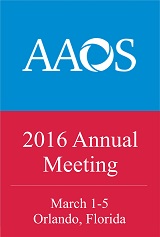
AAOS 2016: 1st metatarsophalangeal hemiarthroplasty reduced surgical time vs. arthrodesis

AAOS 2016: 1st metatarsophalangeal hemiarthroplasty reduced surgical time vs. arthrodesis
First Metatarsophalangeal Hemi Arthroplasty with a New Synthetic Cartilage Implant: Surgical and Recovery Time
Did you know you're eligible to earn 0.5 CME credits for reading this report? Click Here
CONFERENCE ACE REPORTS
This ACE Report is a summary of a conference presentation or abstract. The information provided has limited the ability to provide an accurate assessment of the risk of bias or the overall quality. Please interpret the results with caution as trials may be in progress and select results may have been presented.
Synopsis
180 patients with arthritis of the first metatarsophalangeal joint were randomly assigned to receive either arthrodesis or hemiarthroplasty using a small synthetic cartilage implant (Cartiva). The purpose of this study was to compare these two techniques in terms of surgical time, recovery time, and clinical outcomes at up to 6 weeks postoperatively. The results displayed that surgical times were ...
To view the full content, login to your account,
or start your 30-day FREE Trial today.
FREE TRIAL
LOGIN
Forgot Password?
Explore some of our unlocked ACE Reports below!

Learn about our AI Driven
High Impact Search Feature
Our AI driven High Impact metric calculates the impact an article will have by considering both the publishing journal and the content of the article itself. Built using the latest advances in natural language processing, OE High Impact predicts an article’s future number of citations better than impact factor alone.
Continue



 LOGIN
LOGIN

Join the Conversation
Please Login or Join to leave comments.